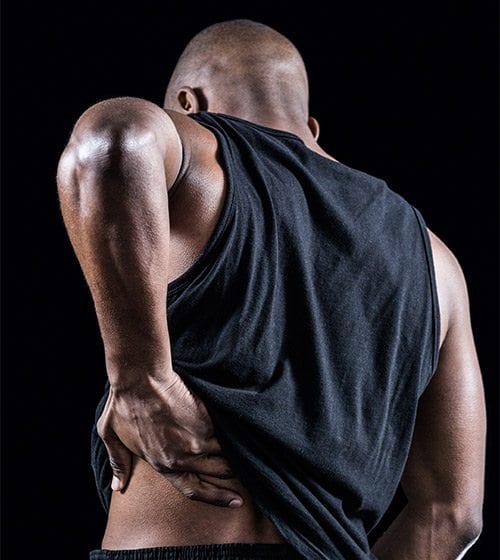
Low back pain is one of the leading causes of disability and the third most common complaint for an office visit, according to the National Center for Health Statistics. It costs the U.S. economy at least $100 billion a year in lost wages and productivity and medical treatment. The cost is largely due to the volume. It is estimated that 80 percent of people in this country will suffer back pain at some point in their lives. No one gets a pass. It strikes people of all ages, races and ethnicities and both genders.

Author: Brigham and Women’s HospitalDr. Zacharia Isaac, who specializes in pain management, counsels a patient at Brigham and Women’s Hospital.
A closer look at the spine will make it clear why the back is so vulnerable. The spine is an intricate curved system of 33 bones called vertebrae. In between the vertebrae are spongy pads called discs, which act as shock absorbers. At each step when walking the discs prevent the bones from rubbing together. A network of muscles and ligaments, nerves and tendons completes the system.
The spine has enormous responsibility. It allows us to stand upright as well as bend forward and backward and twist from side to side. More importantly, it protects the spinal cord. The bones in the neck have to carry the weight of the head, but the bones in the low back bear the brunt of the weight of the entire upper body. That’s an awfully big job for five relatively small bones.
The spine is far from frail, however. When the system is in sync, it does a yeoman’s job. Yet, strains, injuries and diseases can throw it off kilter and pain results. Because of the spine’s intricacy, the problem can stem from a number of sources. The bone might fracture, largely due to osteoporosis; the joints can be attacked by arthritis; the disc can bulge or even burst.
Risk factors
Several factors increase the risk for LBP. The bones and discs begin to wear with age. Weight and inactivity weaken the spine. Unfortunately, almost 37 percent of adults in this country are obese, according to the Centers for Disease Control and Prevention, and only 21 percent meet the recommendations for performing aerobic and muscle strengthening exercises.
Tobacco smoke impedes the delivery of nutrients to the disks in the back. Poor body mechanics, such as improper lifting or bad posture place undue stress on the spine. Even emotions have an impact. There is a link between LBP and depression and anxiety.
Acute pain
Most episodes of LBP are acute and fortunately short-lived. An example is muscle strain, which may be caused by aggressive exercise, poor posture or even just bending down to pick something up from the floor. Though often excruciating, this pain is typically self-limited, and goes away with simple home remedies, such as heat or cold and NSAIDs, such as ibuprofen.
In other instances the pain is not confined to the back. Rather, it travels, or radiates to the buttocks and down the back of the leg. The culprit here is the sciatic nerve — the longest and largest nerve in the body. Because of its location in the lower spine, it is directly in the line of fire. When a disc slips out of place or ruptures, expelling its cushioning gel, it pushes into sciatic territory. You will feel the impact. The pain can be accompanied by tingling, numbness or weakness. Some people get foot drop.
The sciatic nerve wields an awful lot of power over the leg. When irritated, it impairs the ability to walk, jump and control the ankle. The pain is worse when sitting or standing too long. Most cases of sciatica respond to conservative treatment, although severe pain may require epidural steroid injections, which are x-ray-guided infusion of anti-inflammatories.

The spine: The body’s ‘backbone’ — A complex system with many moving parts
The lumbar region of the spine, referred to as the lower back, consists of five large moveable vertebrae (bones) that are labelled L1 to L5. It has a slight inward curve known as lordosis. The lumbar spine is very strong. It supports the weight of the entire torso. It is also very flexible, and allows the body to bend forward and backward and twist from side to side. Because of its flexibility and stress, however, it is more prone to injury.
Discs, which are located between the bones of the spine, serve as shock absorbers. Each disk has a tough outer ring called the annulus and a soft inner core, or nucleus. The nucleus is composed of a gel-like substance that is designed to withstand compression and movement.
A ruptured disc is a common cause of low back pain and sciatica. The disc breaks open allowing the inner gel to escape. The gel can then push against the sciatic nerve, causing radiating pain down the leg. A bulging disc occurs when the disc is compressed and pushes out but remains intact. If it touches the sciatic nerve, it will also cause sciatica.
Most often a herniated or bulging disc can be resolved with conservative treatment. In some cases, it will require surgery. A disc can rupture and bulge without pain, however. Pain is caused when the sciatic nerve is pressed.
Chronic pain: It may be in your head — literally
Pain that lingers three months or more — even after treatment — is considered chronic pain. The incidence of chronic LBP is on the rise. In 1990, it ranked the sixth most burdensome condition in the U.S. in terms of poor health. In 2010, it jumped to third place, according to the National Institute of Neurological Disorders and Stroke.
It is chronic pain that concerns Dr. Zacharia Isaac, the medical director of the Comprehensive Spine Center of Brigham and Women’s Hospital. He faces an uphill battle. Although in many circumstances a diagnosable cause of chronic pain persists, in some instances the brain has somewhat short-circuited, and has not recalibrated even after the initial cause of pain has been eradicated. Researchers discovered that chronic pain is like an old memory that seems to perseverate in the part of the brain that controls emotions and learning.
Isaac has a hard sell. “Pain does not equal damage,” he explained. “Pain can just be pain.”
It’s not unusual for the brain to play tricks on you. Amputees often experience “phantom pain” or “phantom sensation” in which the brain keeps sending feedback that the leg still exists. It may be a little easier for amputees to tolerate this miscue since visual cues — the leg is obviously not there — can help more easily override the messages from the brain. People suffering from LBP don’t have the luxury of actually seeing the insides of the spine.
Isaac tries to encourage normalcy. “People fixate on anatomy [LBP] instead of the entire body,” he explained. “That starts a real bad cycle. People begin to avoid activities.” He pushes exercise, but not only for a strong core. Exercise causes the brain to release endorphins, the body’s natural pain-killers.
Brigham and Women’s Comprehensive Spine Center
http://www.brighamandwomens.org/Departments_and_Services/spinecenter/Default.aspx#pageheadline
Treatment
Because LBP involves so many organ systems it requires a comprehensive approach to care, said Isaac. Physical therapy and exercise, acupuncture, chiropractic, yoga and t’ai chi are key players. Surgery is generally restricted to acute cases that impair urinary functions or result in severe or progressive weakness, for example, as well as potential candidates who have not improved after a couple of months of conservative treatment.
Emotional support in the form of cognitive behavior and mindfulness is pivotal. A recent study published in JAMA found that among adults with chronic LBP, treatment with mindfulness or cognitive behavioral therapy resulted in greater improvement in back pain than did usual care. The improvements persisted for a year.
There is not a quick fix for chronic LBP. There’s no magic pill. However, newer techniques are available now to help “reprogram” the brain’s pain signals.






